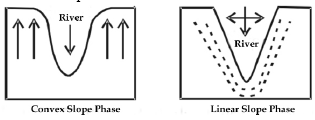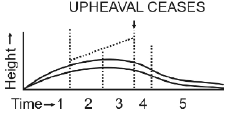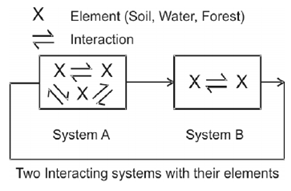Question : Discuss with examples the influence of vulcanism and diastrophism on the evolution of landscape.
(1993)
Answer : There are various geological processes, forces and resultant movements which are involved in the creation, destruction, recreation and maintenance of geomaterials and numerous types of relief features, and thereby in the evolution of landscape. Of these, Endogenetic Forces coming from within the earth introduce various types of vertical irregularities such as mountains, plateaus, plains, lakes, folds, faults, craters etc. Vulcanism and diastrophism are also the expressions of endogenetic forces which contribute significantly in the evolution ....
Question : Discuss the contribution of the American school of subaerial Denudation in geomorphology.
(2015)
Answer : American school of denudation is largely contributed by Williams Moris Davis who gave the concept of normal cycle of erosion. This normal cycle of erosion incorporated the fluvial action for landform genesesis and divided it into 3 different stages-young, mature and old stage.
Question : Explain with examples, as to how channel dynamic has been responsible for the development of alluvial fans and cones.
(2015)
Answer : River deposit sediments in different parts of their courses and thus form varioustypes of landforms which are called constructional landforms such as alluvial fans and alluvial cones.
They are formed at foothillswhere there is abrupt drop in the channel gradient. The transporting capacity of the stream decreases enormouslyat the foothills where they leave mountains and enter the plain topography. Consequently, load consisting of, fine to coarser and big sized materials coming from up stream is deposited ....
Question : Attempt a classification of geomorphic process from zonal point of view.
(2015)
Answer : Broadly geomorphic processes are classified into two—endogenetic and exogenetic processes. endogenetic forces modify the earth’s surface by operating from internal part of the earth.
While exogenic processes originates from the atmospheric part of the earth and operate to modify the earth’s surface.
Some of the geomorphic processes which differ in their zone of operations can be broadlysummed up as—
Question : Discuss the salient features of ‘sirocco’ and ‘mistral’.
(2014)
Answer : Sirocco
Question : State the concept of plate tectonics. How does it help in explaining the formation of the Himalayas and Appalachian Mountains?
(2014)
Answer : The concept of plate tectonics was formulated in the 1960s. According to this theory, Earth has a rigid outer layer, known as the lithosphere, which is typically about 100 km (60 miles) thick and overlies a plastic layer called the asthenosphere. The lithosphere is broken up into about a dozen large plates and several small ones. These plates move relative to each other, typically at the rate of 5 to 10 cm (2 to 4 ....
Question : Define the term ‘meander’ and describe the basic characteristics of entrenched meander and ingrown meander.
(2014)
Answer : In large flood and delta plains, rivers rarely flow in straight courses. Loop like channel patterns, called meanders develop over flood and delta plains. Meander refers to the bends in the longitudinal course of river. Meander is not a landform but is a type of channel pattern.
This is because of:
Question : State the concept of erosion surfaces and highlight the factors responsible for their development.
(2014)
Answer : ‘Erosional surfaces’ are the combined result of erosional and depositional processes. It is an almost plain topographic surface having undulated ground surface and remnants of low relief caused by dynamic wheels of denudational processes and cutting across geological formations and structures and is generally called erosion or planation surface. They can be formed by various factors. Majorly they can be-
Aeolian processes are generally specific to the action caused by wind. ....
Question : Explain weathering and mass wasting, and describe their geomorphic significance.
(2014)
Answer : Weathering: Disintegration or alteration of rock in its natural or original position at or near the Earth’s surface through physical, chemical, and biological processes, induced or modified by wind, water, and climate.
Question : Compare the Subsidence and Glacial control theories on the formation of coral reefs.
(2013)
Answer : Darwin’s subsidence and Daly’s “glacial control” theory of the origin and development of coral reefs are complementary rather than mutually exclusive, but Daly misconceived the processes operating during the Pleistocene glaciations and hence the forms resulting from them. New data on the marine and subaerial erosion of reef limestones, and on the rate of growth of reefs under different conditions, show that modern reefs, only a few thousand years old, veneer much older and larger ....
Question : “Offshore Acoustic Study helped the development of the concept of sea floor spreading.” Explain.
(2013)
Answer : Sound in the sea, which oceanographers refer to as “underwater acoustics,” offers the most effective means of exploring a wide variety of natural phenomena over large regions of the global ocean. The unique properties of temperate and tropical seas result in a permanent layer in the ocean in which sound energy can propagate over great distances with very little signal loss. By placing underwater listening devices (hydrophones) within this layer, sound can be monitored from ....
Question : What is ‘Base level’? Explain the types of base level.
(2013)
Answer : The base level of a river or stream is the lowest point to which it can flow, often referred to as the ‘mouth’ of the river.The two general types of base level (the lowest point to which a stream may erode its channel) are (1) Ultimate base level- for most streams is the ocean, though those that empty into closed depressions like Death Valley or the Dead Sea or even a small sinkhole are exceptions.Base ....
Question : Impact of Pleistocene Ice Age on the crust of the Earth.
(2013)
Answer : During glaciation, water from the oceans turned into ice at high latitudes, thus global sea level dropped by about 110 meters, exposing the continental shelves and forming land-bridges between land-masses for animals to migrate. During deglaciation, the melted ice-water returned to the oceans, causing sea level to rise. This process can cause sudden shifts in coastlines and hydration systems resulting in newly submerged lands, emerging lands, collapsed ice dams resulting in salination of lakes, new ....
Question : Differences between Normal cycle and Arid cycle of Davis.
(2013)
Answer : The processes eroding the landscape were grouped together by Davis under one heading, ‘NORMAL’. He did not explicitly define ‘normal’ but by implication he meant the assemblage of processes dominating the temperate landscapes of N.America and Europe (where he worked) and especially the action of running water. That is, by the term ‘normal’ he meant the fluvial cycle of erosion prevalent in humid region.
Question : Characteristics of the standard epigene cycle of erosion.
(2012)
Answer : Epigene means taking place or produced on the surface of the earth.Characteristics of Epigene Cycle of Erosion were explained by L. C. King whose model contrasted with Davis and borrowed heavily from Phase concept and slope development theories.
Question : Explain how Bosche and Haldenhang lead to the Theory of Slope Replacement.
(2012)
Answer : Walther Penck Propounded Slope Replacement Theory in context of slope development. He explained the development of slope through erosion cycle of running water. He rejected Davison stage model and gave concept of phases which are characterized by inter-relation between upliftment and erosion.


According to Penck, different rates of erosion and upliftment decide the phase of slope development. There are three phases in Penck’s model:
Phases of Penck’s cycle of erosion
Question : Palaeozoic glacial evidence for Continental Drift.
(2012)
Answer : Professor Alfred Wegener propounded the dynamic continents after proving static continents in ocean in his continental drift theory. He took the help of paleo climate. There have been many evidences which prove that climate changed over a place from time to time.

These changes could be explained - only if a place is static while climate regions are moving or if climate regions were static while land is moving. Wegener ....
Question : Systems approach to landform analysis.
(2012)
Answer : Landform analyses involves study of relief, its formation processes and relation with man. With the help of systems approach, geographical principles and results about analysis of land and sea surface, their origin and development can be made more scientific, logical and useful.
Geography inherited system approach from general system theory of Bertalanffy. According to the general system theory, a system involves elements and interactions between them. The elements are not only related but have a kind ....
Question : Highlight the geomorphic features essentially found in topographics under the second cycle of erosion.
(2009)
Answer : Cycle of erosion is a period of time during which an uplifted landmass undergoes its transformations by the process of lands culture ending into low features plains. According to W.M. Davis the videal normal cycle of erosion can pass through the three stages i.e. youth, mature and old under the region remains in stand still position for longer duration of crustal stability but the availability of such condition is of far possibility because the earth ....
Question : Critically examine the concepts of geomorphological cycle and discuss the views
(2008)
Answer : Based on the inheritance of James Hutton’s concept of the cyclic nature of the earth’s history and the evolutionary concept of Charles Darwin, W.M. Davis presented his concept of ‘geographical cycle of erosion’ in 1899. This was based on the basic concept of “sequential change in landforms through time like the evolution of an organic life”
According to Davis, landforms undergo sequential changes through time (passing through three stages of youth, mature and old). Two types ....
Question : Define the concept of isostasy and discuss the postulations of Airy and Pratt.
(2007)
Answer : The theory of isostasy postulates a system for the distribution of material in the earth’s crust which conforms to and explains the observed gravity values. This theory was developed from gravity surveys in the mountains of India around 1850s. The results show that the actual force of gravity over the mountain range is considerably less than what it should be theoretically.
The concept of isostasy means that a state of equilibrium or balance exists in the ....
Question : Critically evaluate the continental drift hypothesis of A. Wegener.
(2006)
Answer : The drifing of continents was first suggested by the French scholar Antonio Snider in 1858, but this was so much opposed to the scientific view that nobodytook notice of it.
In 1910, F.B. Taylor of America invoked the hypothesis of horizontal displacement or continental drift with a view to explain the distribution of mountain ranges, but due to various reasons the hypothesis of Taylor received scant attention. German professor Alfred Wegener was the first to present ....
Question : Role of seismic waves in the study of earth’s interior:
(2005)
Answer : Seismology is the only reliable source which gives reliable knowledge about the interior of the earth.
There are three types of seismic wave:
Question : “Structure is a dominant control factor in the evolution of landforms.” Discuss with suitable examples.
(2005)
Answer : The given statement represents the geographical cycle of Davis. The gist of the cyclic concept is that commencing with an initial landscape, generally assumed to be one of low relief, the land surface passes through an orderly sequence of forms and eventually returns to a surface of low relief.
views that in order to understand the evolution of a particular land form/landscape, it is extremely important to know the stages of development were influenced by Davis. ....
Question : Describe the landforms which are products of endogenetic forces.
(2004)
Answer : There are various geological processes, forces and resultant movements which are involved in the creation, destruction, recreation and maintenance of geomaterials and numerous types of relief features. These forces are divided into two broad categories—Endogenetic Forces and Exogenetic Forces. Endogenetic forces refers to the forces coming from within the earth.
The interation of matter and temperature generates endogenetic forces or movements inside the earth. These forces introduce/produce various types of vertical irregularities and land forms such ....
Question : Explain the sequential development of landforms associated with the coastal areas.
(2003)
Answer : The theoretical cycle of marine erosion suggests that shoreline development follows a sequential order in which characteristic land forms are formed in different stages. In the initial stage most coasts are irregular but the normal tendency of marine erosion is to make the coasts regular in course of time. Hence initially erosional land forms are formed. After a period of time, the formation of depositional features start taking place. The depositional process dominates in the ....
Question : Provide a critique of the ‘geographical cycle’ model propounded by Davis.
(2002)
Answer : ‘No vestige of a begining; no prospect of an end’ and present is the key to the past, were few dictums which were debated before Davisian model of geographical cycle, came into existence in 1899. This model is based on the basic concept of sequential change in landform through time like the evolution of an organic life.
Davis has assumed two forces affecting the land surface:
(i)Endogenetic
(ii)Exogenetic
Question : With reference to the theory of Plate Tectonics, explainthe origin and growth of the Young Fold Mountain Systems of the world.
(2000)
Answer : Plate Tectonics is the most comprehensive and systematic theory which provides for the best and the most rational explanation for the distribution of oceans and continents, ridges and trenches and organic zones and the various process leading to these. According to this theory, the upper portion of the lithosphere is believed to consist of a mosaic of rigid plates, with an estimated average depth of about 100 Km. These plates are embedded in a somewhat ....
Question : Bring out the distinctions between the continental drift theory and the plate Tectonics theory.
(1999)
Answer : The most comprehensive and synthetic theory of Plate Tectonics which provides most rational explanation for many geologic and geomorphic phenomena, has evolved in a long process involving many researches, ideas and hypothesize the genesis of which can be rightly traced back to the theory of continental drift. The idea of continental movement relative to each other, originally suggested by Antonio Snider and later enriched by F.B. Taylor, was developed by German meteorologist Alfred Wegener, into ....
Question : Discuss the concept of volcanicity and show how the theory of plate tectonics explains the mechanism of volcanism and volcanic eruption.
(1998)
Answer : Volcanism includes all phenomena connected with the movement of treated material from the interior towards surface of the earth. In other words, volcanicity includes all those processes and mechanisms which are related to the origin of magmas, gases and vapour, their ascent and appearance on the earth surface in various forms.
Now it becomes clear that volcanicity has two components:
Question : Discuss the process of mechanical and chemical weathering and show their relationship with soil formation.
(1996)
Answer : Weathering has been defined as the total of all processes acting at or near the earth's surface to cause physical disruption and chemical decomposition of rocks in situ. Weathering by itself is a static process and does not involve removal of material. In other words, weathering is the process by which rocks are broken down and decomposed by the action of external agencies such as wind, rain, temperature changes, plates, bacteria, etc. Thus weathering is ....
Question : Discuss the limitations of the theory of Continental Drift and show how the theory of Plate Tectonics is an improvement over it.
(1995)
Answer : The modern theory of Plate Tectonics which provides most rational explanation for many geologic and geomorphic phenomena has evolved in a long process involving many researches, ideas and hypothesises the full scale genesis of which can be rightly traced back to the theory of Continental Drift. This view of non- stationary continents, first suggested by Antonio Snider and later enriched by F.B. Taylor,was developed by German meteorologist Alfred Wegener into a full-scale hypothesis.
In his theory ....